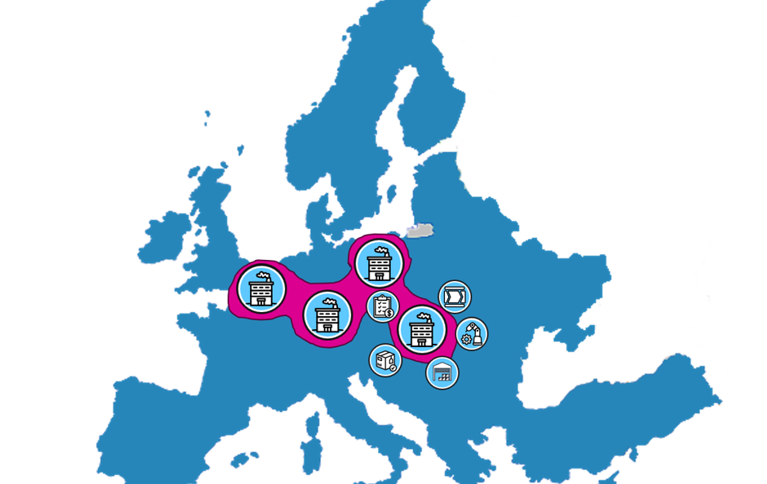3 Feb 2025
Full Footprint Transparency
Optimizing and Rationalizing Production

Executive Summary
In today’s competitive manufacturing environment, achieving production efficiency and cost optimization is critical. Companies often operate multiple production sites with overlapping capabilities, yet face challenges such as underutilization, overcapacity, and low transparency across their operations. By treating the entire factory footprint as a single production capability, organizations can unlock hidden capacity, optimize utilization, and even consolidate operations where necessary.
Ortelius has successfully enabled organizations to achieve these goals by creating full footprint transparency, facilitating a shift from 30% undercapacity to 30% spare capacity in one case. This white paper outlines the methodology and benefits of optimizing and rationalizing production using this approach.
The Idea in Brief
Optimizing and rationalizing production begins with achieving full transparency of the production footprint. By visualizing the total factory network as a unified production entity, significant efficiencies can be realized. This process involves mapping and harmonizing:
- Production capabilities
- Brands and product portfolios
- Input materials
- Bills of Materials (BOMs)
Ortelius’ role encompasses identifying production capabilities, ensuring product portfolio clarity, harmonizing input materials, and making BOMs comparable. Additionally, limitations, prerequisites, and dependencies are mapped to create actionable insights. With this foundation, companies can unlock spare capacity, simulate operational changes, and consolidate sites effectively.

Achieving Full Footprint Transparency
Key Dimensions
- Production Capabilities: Comprehensive mapping of equipment, processes, and site capabilities ensures clarity on production strengths and limitations.
- Brands and Products: Creating transparency in product portfolios helps identify overlapping product lines and rationalization opportunities.
- Input Materials: Harmonizing material requirements across sites ensures standardization and reduces complexity in sourcing and planning.
- Bills of Materials (BOMs): Ensuring BOMs are consistent and comparable enables seamless planning and resource allocation.
Methodology
- Mapping and Defining: Collect data on production capabilities, product portfolios, input materials, and BOMs.
- Transparency Creation: Harmonize and structure data to enable comparability and a clear understanding of the companies unique footprint and products.
- Scenario Simulations: Use transparency to generate scenarios such as capacity increases, site consolidation, and product migration.
- Actionable Insights: Enable data-driven decisions that align with the company’s business model and goals.
Key Benefits
By adopting a holistic view of production capabilities, Ortelius has delivered the following measurable benefits:
- Capacity Optimization: Shift from 30% undercapacity to 30% spare capacity.
- Cost Simulations: Model and evaluate the financial impact of factory closures and consolidations.
- Production Scalability: Support Industry 4.0 initiatives by optimizing factory readiness for digital transformation.
- Improved Contingency: Enhance operational resilience by better understanding production dependencies and bottlenecks.
- Accelerated Time to Market: Optimize production flows for faster product delivery.
Realizing Opportunities
Starting Point
- Multiple production sites with overlapping capabilities and product ranges.
- Challenges with capacity management and transparency.
- Lack of data standardization across sites.
The Transformation Process
- Achieve Transparency: Build a unified view of production capabilities, input/output materials, and dependencies.
- Optimize as One Unit: Treat the entire factory network as a single production capability.
- Leverage Digital Tools: Enable advanced planning and simulation capabilities.
- Drive Continuous Improvement: Use insights to support ongoing optimization and rationalization.

Key Success Factors
For effective optimization and rationalization, the following factors are critical:
- Attention to Detail
- Thorough mapping of production capabilities, prerequisites, and constraints is essential.
- Product Transparency
- Documenting product similarities, differences, and prerequisites ensures effective rationalization.
- Understanding Rules and Limitations
- Identifying production-specific rules enables better scenario planning and decision-making.
- Data Structure and Definitions
- A firm data foundation ensures seamless cross-site transparency and operational alignment.
- Collaboration Across Teams
- Close coordination with supply chain and product experts ensures that insights are actionable and relevant.
- Openness to Change
- Embracing new ways of working and adapting to insights is crucial for success.
Execution: Example deliverables for realizing value

Result
Various execution applications, for example:
- Dynamic Planning Tool
- Order Tracking Tool
- New Product Configuration Tool
Conclusion
Optimizing and rationalizing production through full footprint transparency unlocks significant value for manufacturing organizations. By viewing the entire factory network as a unified system, companies can increase capacity, reduce costs, and adapt to changing market demands. Each project is tailored to the unique needs, circumstances, and business models of the customer to ensure success.
Ortelius’ proven methodology and expertise in enabling transparency and optimization serve as a valuable resource for organizations seeking to enhance their production efficiency and readiness for the future.

